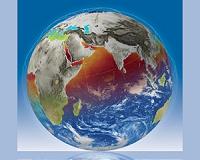 |
Guildford, UK (SPX) Feb 18, 2011 A UK-led international consortium that uses satellite imagery to provide disaster mitigation celebrates its ten year anniversary this week as its members meet in London to plan for the coming decade. The Disaster Monitoring Constellation is a unique international partnership formed by national governments and organisations that recognised the need for coordinated satellite imaging campaigns to assess and mitigate natural disasters with more up to date and timely information a decade ago. The five consortium members each own an independent satellite, but pool their resources to gather and distribute up to date images of disaster stricken areas anywhere in the world. By working together, the multi-satellite constellation provided the unique capability to acquire satellite images of anywhere on Earth at least once a day. This makes it possible to provide recent high quality images of the effected area within the critical days following a disaster, improving the accuracy of maps and emergency response plans that are made. DMC International Imaging Ltd (DMCii) was set up to coordinate disaster response and to distribute images. In partnership with the former British National Space Centre (BNSC) and the Constellation members, DMCii uses the commercial exploitation of the satellite images to fund coordination of the Constellation for humanitarian use during natural disasters. DMCii works with the world's space agencies and the United Nations (UN) within the International Charter : Space and Major Disasters to provide multi-spectral optical imagery during natural disasters. The constellation responds to disasters frequently and has played an important role responding to disasters such as Hurricane Katrina (2005), Asian Tsunami (2004), UK floods (2007), and the Sichuan Earthquake (2008). All of the Constellation satellites were designed and built by Surrey Satellite Technology Ltd (SSTL), the British space company that earned support from the BNSC to developed a highly cost effective new type of satellite that was smaller and much more economical to launch than contemporary designs. Building on the success of demonstration missions such as Tsinghua-1, SSTL built satellites that provided Consortium members with cost effective sovereign remote sensing capability with shared ground segment, image processing and distribution - and an essential role in international disaster response. The Constellation's unique daily imaging and very large 650km wide high resolution images have also opened the door to applications that were previously thought impossible such as the regular and timely monitoring of crop growth. Since 2004, the Amazon rainforest has been imaged in high resolution twice a year to measure deforestation and pinpoint illegal logging compared to previous decadal studies. Dr. S. O. Mohammed, Director General of the Nigerian Space agency (NASRDA) commented, "In joining the DMC we have not only developed our knowledge of Nigeria's resources but also formed the foundations for our growing national space programme. We are proud to have made a valuable contribution to this unique international partnership." Dave Hodgson, Managing Director DMCii commented, "We have achieved a great deal during the past ten years, made possible only by the unique international partnership of the Disaster Monitoring Constellation. "By coordinating multiple satellites we have been able to respond to disasters more rapidly and detect fast changing phenomena with daily images of anywhere on Earth. "As new satellites and new members join the Constellation, we have proven this model to be sustainable and look forward to expanding its capabilities to meet the needs of our members long into the future," said Hodgson. The Disaster Monitoring Constellation has been very successful and the new missions UK-DMC-2 and Deimos-1 launched in 2009 provided not only continuity of data, but also huge improvements in the amount of imagery that the Constellation is able to acquire. Now in 2011, the Nigerian Space Agency (NASRDA) will launch NigeriaSat-2 which provides high resolution 2.5m panchromatic imaging and highly advanced wide-area imaging and a NigeriaSat-X to provide data continuity from NigeriaSat-1. Both these new satellites will join the Constellation, and a data deal between NASRDA and DMCii to distribute imagery from NigeriaSat-2 was announced just last week. This week in London the Consortium members will review several new technologies for monitoring the Earth to decide what future capabilities the Constellation requires. Recent technological developments at SSTL make it possible for a single satellite to image the Earth's landmass every day, or for a small and cost effective satellite to provide very high resolution sub-1m images of the Earth. Synthetic Aperture Radar (SAR) payloads that can image through clouds or smoke are also now being considered for future Constellation satellites.
Share This Article With Planet Earth
Related Links Surrey Satellite Technology Limited Earth Observation News - Suppiliers, Technology and Application
 Biogeochemistry At The Core Of Global Environmental Solutions
Biogeochemistry At The Core Of Global Environmental SolutionsMillbrook NY (SPX) Feb 14, 2011 If society wants to address big picture environmental problems, like global climate change, acid rain, and coastal dead zones, we need to pay closer attention to the Earth's coupled biogeochemical cycles. So reports a special issue of Frontiers in Ecology and the Environment, published this month by the Ecological Society of America. "There are nearly seven billion people on the planet. An ... read more |
|
| The content herein, unless otherwise known to be public domain, are Copyright 1995-2010 - SpaceDaily. AFP and UPI Wire Stories are copyright Agence France-Presse and United Press International. ESA Portal Reports are copyright European Space Agency. All NASA sourced material is public domain. Additional copyrights may apply in whole or part to other bona fide parties. Advertising does not imply endorsement,agreement or approval of any opinions, statements or information provided by SpaceDaily on any Web page published or hosted by SpaceDaily. Privacy Statement |